Amino-Functionalized Fe3O4@SiO2 Core-Shell Magnetic Nanoparticles for Dye Adsorption
Abstract
:1. Introduction
2. Materials and Methods
2.1. Synthesis Procedure
2.2. Characteristic Methods
3. Results and Discursion
3.1. NPs Structure and Morphology
3.2. NPs Magnetic Properties
3.3. Application of Synthesized NPs as Fluorescent Probes
3.4. Application of Synthesized NPs for Dye Adsorption
3.4.1. Adsorption Kinetics
3.4.2. Adsorption Isotherms
4. Conclusions
Author Contributions
Funding
Institutional Review Board Statement
Informed Consent Statement
Data Availability Statement
Conflicts of Interest
References
- Li, J.; Yuan, Z.; Liu, H.; Feng, J.; Chen, Z. Size-dependent tissue-specific biological effects of core–shell struc-tured Fe3O4@SiO2–NH2 nanoparticles. J. Nanobiotechnol. 2019, 17, 124. [Google Scholar] [CrossRef] [Green Version]
- Aslani, E.; Abri, A.; Pazhang, M. Immobilization of trypsin onto Fe3O4@SiO2–NH2 and study of its activity and stability. Colloids Surf. B Biointerfaces 2018, 170, 553–562. [Google Scholar] [CrossRef]
- Izgi, M.S.; Ece, M.Ş.; Kazici, H.Ç.; Şahin, Ö.; Onat, E. Hydrogen production by using Ru nanoparticle decorated with Fe3O4@SiO2–NH2 core-shell microspheres. Int. J. Hydrog. Energy 2020, 45, 30415–30430. [Google Scholar] [CrossRef]
- Veisi, H.; Ozturk, T.; Karmakar, B.; Tamoradi, T.; Hemmati, S. In situ decorated Pd NPs on chitosan-encapsulated Fe3O4/SiO2-NH2 as magnetic catalyst in Suzuki-Miyaura coupling and 4-nitrophenol reduction. Carbohydr. Polym. 2020, 235, 115966. [Google Scholar] [CrossRef]
- Salman, M.; Jahan, S.; Kanwal, S.; Mansoor, F. Recent advances in the application of silica nanostructures for highly improved water treatment: A review. Environ. Sci. Pollut. Res. 2019, 26, 21065–21084. [Google Scholar] [CrossRef] [PubMed]
- Xie, H.; Wu, Z.; Wang, Z.; Lu, J.; Li, Y.; Cao, Y.; Cheng, H. Facile fabrication of acid-resistant and hydrophobic Fe3O4@SiO2@C magnetic particles for valid oil-water separation application. Surf. Interfaces 2020, 21, 100651. [Google Scholar] [CrossRef]
- Zhang, S.; Zhang, Y.; Liu, J.; Xu, Q.; Xiao, H.; Wang, X.; Xu, H.; Zhou, J. Thiol modified Fe3O4@SiO2 as a robust, high effective, and recycling magnetic sorbent for mercury removal. Chem. Eng. J. 2013, 226, 30–38. [Google Scholar] [CrossRef] [Green Version]
- Ghorbani, F.; Kamari, S. Core–shell magnetic nanocomposite of Fe3O4@SiO2@NH2 as an efficient and highly re-cyclable adsorbent of methyl red dye from aqueous environments. Environ. Technol. Innov. 2019, 14, 100333. [Google Scholar] [CrossRef]
- Kamari, S.; Shahbazi, A. Biocompatible Fe3O4@SiO2-NH2 nanocomposite as a green nanofiller embedded in PES-nanofiltration membrane matrix for salts, heavy metal ion and dye removal: Long-term operation and re-usability tests. Chemosphere 2020, 243, 125282. [Google Scholar] [CrossRef]
- Alizadeh, A.; Fakhari, M.; Safaei, Z.; Khodeai, M.; Repo, E.; Asadi, A. Ionic liquid-decorated Fe3O4@SiO2 nanocomposite coated on talc sheets: An efficient adsorbent for methylene blue in aqueous solution. Inorg. Chem. Commun. 2020, 121, 108204. [Google Scholar] [CrossRef]
- Erdem, B.; Avşar, S.B.; Erdem, S.; Tekin, N. Adsorption of light green and brilliant yellow anionic dyes using amino functionalized magnetic silica (Fe3O4@SiO2@NH2) nanocomposite. J. Dispers. Sci. Technol. 2018, 40, 1227–1235. [Google Scholar] [CrossRef]
- Salman, A.D.; Juzsakova, T.; Ákos, R.; Ibrahim, R.I.; Al-Mayyahi, M.; Mohsen, S.; Abdullah, T.A.; Domokos, E. Synthesis and surface modification of magnetic Fe3O4@SiO2 core-shell nanoparticles and its application in up-take of scandium (III) ions from aqueous media. Environ. Sci. Pollut. Res. 2021, 28, 28428–28443. [Google Scholar] [CrossRef]
- Dong, S.; Wang, S.; Wang, X.; Zhai, L. Superparamagnetic nanocomposite Fe3O4@SiO2-NH2/CQDs as fluorescent probe for copper (II) detection. Mater. Lett. 2020, 278, 128404. [Google Scholar] [CrossRef]
- Alenazi, N.A.; Hussein, M.A.; Alamry, K.A.; Asiri, A.M. Nanocomposite-Based Aminated Polyethersulfone and Carboxylate Activated Carbon for Environmental Application. A Real Sample Analysis. C 2018, 4, 30. [Google Scholar] [CrossRef] [Green Version]
- Smit, J.; Wijn, H.P.J. Ferrites: Physical Properties of Ferrimagnetic Oxides in Relation to their Technical Applications; Philips Gloeilampenfabrieken: Eindhoven, The Netherlands, 1959. [Google Scholar]
- Mahdavi, M.; Ahmad, M.B.; Haron, M.J.; Gharayebi, Y.; Shameli, K.; Nadi, B. Fabrication and characterization of SiO2/(3-aminopropyl) triethoxysilane-coated magnetite nanoparticles for lead(II) removal from aqueous solution. J. Inorg. Organomet. Polym. 2013, 23, 599–607. [Google Scholar] [CrossRef]
- Rizvi, S.B.; Ghaderi, S.; Keshtgar, M.; Seifalian, A.M. Semiconductor quantum dots as fluorescent probes for in vitro and in vivo bio-molecular and cellular imaging. Nano Rev. 2010, 1, 5161. [Google Scholar] [CrossRef] [PubMed]
- Zhang, W.-H.; Hu, X.-X.; Zhang, X.-B. Dye-doped fluorescent silica nanoparticles for live cell and in vivo bioimaging. Nanomaterials 2016, 6, 81. [Google Scholar] [CrossRef] [PubMed] [Green Version]
- Chekina, N.; Horák, D.; Jendelova, P.; Trchova, M.; Beneš, M.J.; Hruby, M.; Herynek, V.; Turnovcová, K.; Syková, E. Fluorescent magnetic nanoparticles for biomedical applications. J. Mater. Chem. 2011, 21, 7630–7639. [Google Scholar] [CrossRef]
- Heitsch, A.T.; Smith, D.K.; Patel, R.N.; Ress, D.; Korgel, B.A. Multifunctional particles: Magnetic nanocrystals and gold nanorods coated with fluorescent dye-doped silica shells. J. Solid State Chem. 2008, 181, 1590–1599. [Google Scholar] [CrossRef] [Green Version]
- Slyusareva, E.A.; Gerasimova, M.A. pH-dependence of the absorption and fluorescent properties of fluorone dyes in aqueous solutions. Russ. Phys. J. 2014, 56, 1370–1377. [Google Scholar] [CrossRef]
- Chakraborty, M.; Panda, A.K. Spectral behaviour of eosin y in different solvents and aqueous surfactant media. Spectrochim. Acta A 2011, 82, 458–465. [Google Scholar] [CrossRef] [PubMed]
- Wo, R.; Li, Q.-L.; Zhu, C.; Zhang, Y.; Qiao, G.-F.; Lei, K.-Y.; Du, P.; Jiang, W. Preparation and Characterization of Functionalized Metal–Organic Frameworks with Core/Shell Magnetic Particles (Fe3O4@SiO2@MOFs) for Removal of Congo Red and Methylene Blue from Water Solution. J. Chem. Eng. Data 2019, 64, 2455–2463. [Google Scholar] [CrossRef]
- Wang, P.; Wang, X.; Yu, S.; Zou, Y.; Wang, J.; Chen, Z.; Alharbi, N.S.; Alsaedi, A.; Hayat, T.; Chen, Y.; et al. Silica coated Fe3O4 magnetic nanospheres for high removal of organic pollutants from wastewater. Chem. Eng. J. 2016, 306, 280–288. [Google Scholar] [CrossRef]
- Hamedi, A.; Trotta, F.; Zarandi, M.B.; Zanetti, M.; Caldera, F.; Anceschi, A.; Nateghi, M.R. In Situ Synthesis of MIL-100(Fe) at the Surface of Fe3O4@AC as Highly Efficient Dye Adsorbing Nanocomposite. Int. J. Mol. Sci. 2019, 20, 5612. [Google Scholar] [CrossRef] [Green Version]
- Huang, P.; Xia, D.; Kazlauciunas, A.; Thornton, P.; Lin, L.; Menzel, R. Dye-mediated interactions in chitosan-based polyelectrolyte/organoclay hybrids for enhanced adsorption of industrial dyes. ACS Appl. Mater. Interfaces 2019, 11, 11961–11969. [Google Scholar] [CrossRef] [PubMed] [Green Version]
- Gouamid, M.; Ouahrani, M.R.; Bensaci, M.B. Adsorption equilibrium, kinetics and thermodynamics of methylene blue from aqueous solutions using Date palm Leaves. Energy Procedia 2013, 36, 898–907. [Google Scholar] [CrossRef] [Green Version]
- Qu, L.; Han, T.; Luo, Z.; Liu, C.; Mei, Y.; Zhu, T. One-step fabricated Fe3O4@C core–shell composites for dye removal: Kinetics, equilibrium and thermodynamics. J. Phys. Chem. Solids 2015, 78, 20–27. [Google Scholar] [CrossRef]
- Harsini, N.N.; Ansari, M.; Kazemipour, M. Synthesis of Molecularly Imprinted Polymer on Magnetic Core-Shell Silica Nanoparticles for Recognition of Congo Red. Eurasian J. Anal. Chem. 2018, 13, 20. [Google Scholar] [CrossRef]
- Zhang, M.; Yu, Z.; Yu, H. Adsorption of eosin Y, methyl orange and brilliant green from aqueous solution using ferroferric oxide/polypyrrole magnetic composite. Polym. Bull. 2020, 77, 1049–1066. [Google Scholar] [CrossRef]
- Sadeghi, M.; Irandoust, M.; Khorshidi, F.; Feyzi, M.; Jafari, F.; Shojaeimehr, T.; Shamsipur, M. Removal of arsenic (III) from natural contaminated water using magnetic nanocomposite: Kinetics and isotherm studies. J. Iran Chem. Soc. 2016, 13, 1175–1188. [Google Scholar] [CrossRef]
- Weber, W.J.; Morris, J.C. Kinetics of adsorption on carbon from solutions. J. Sanit. Eng. Div. Am. Soc. Civ. Eng. 1963, 89, 31–60. [Google Scholar] [CrossRef]
- Allen, S.; Mckay, G.; Porter, J. Adsorption isotherm models for basic dye adsorption by peat in single and binary component systems. J. Colloid Interface Sci. 2004, 280, 322–333. [Google Scholar] [CrossRef] [PubMed]
- Yimin, D.; Jiaqi, Z.; Danyang, L.; Lanli, N.; Liling, Z.; Yi, Z.; Xiaohong, Z. Preparation of Congo red functionalized Fe3O4@SiO2 nanoparticle and its application for the removal of methylene blue. Colloids Surf. A 2018, 550, 90–98. [Google Scholar] [CrossRef]
- Meng, C.; Zhikun, W.; Qiang, L.; Chunling, L.; Shuangqing, S.; Songqing, H. Preparation of ami-no-functionalized Fe3O4@mSiO2 core-shell magnetic nanoparticles and their application for aqueous Fe3+ removal. J. Hazard. Mater. 2018, 341, 198–206. [Google Scholar] [CrossRef] [PubMed]
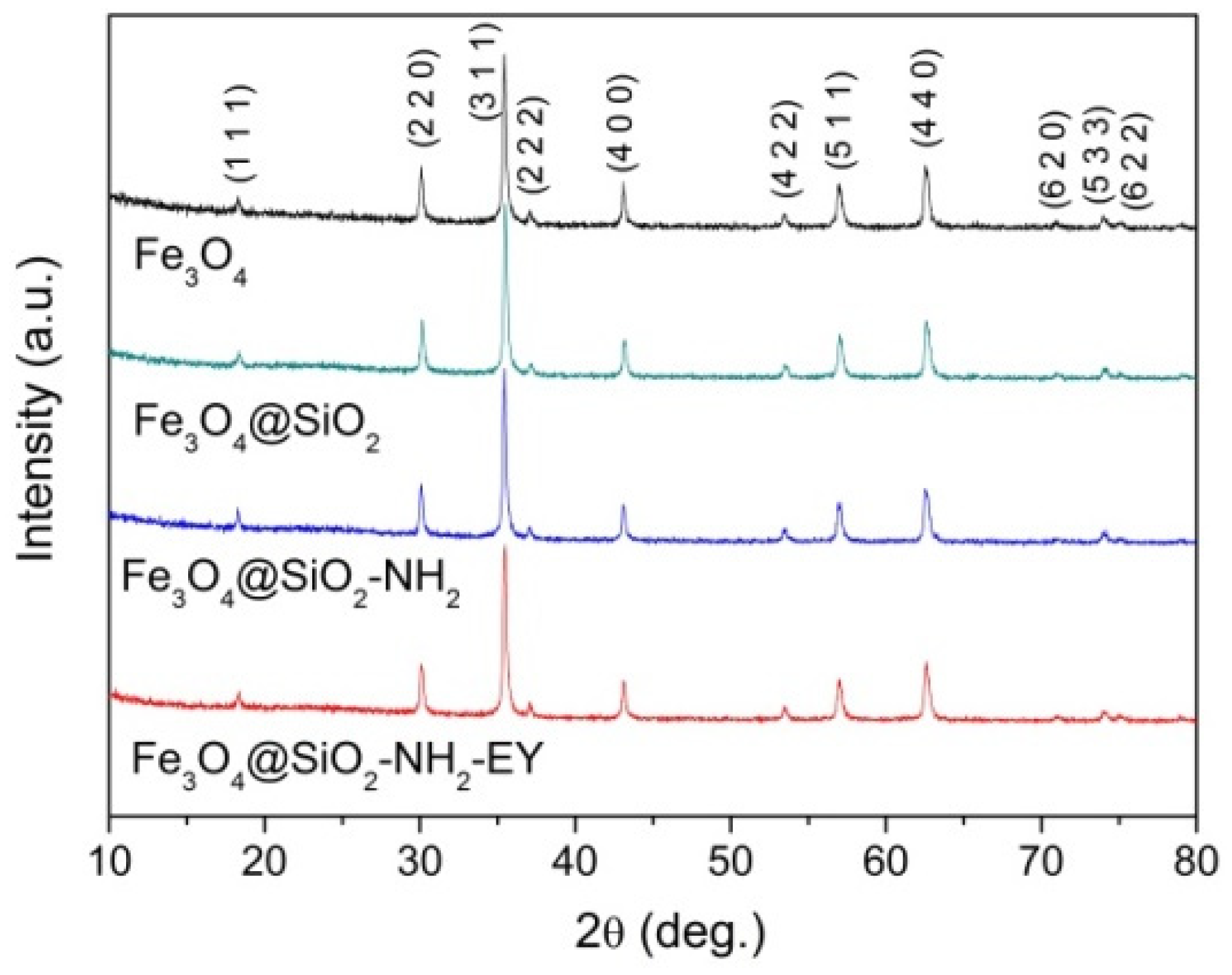

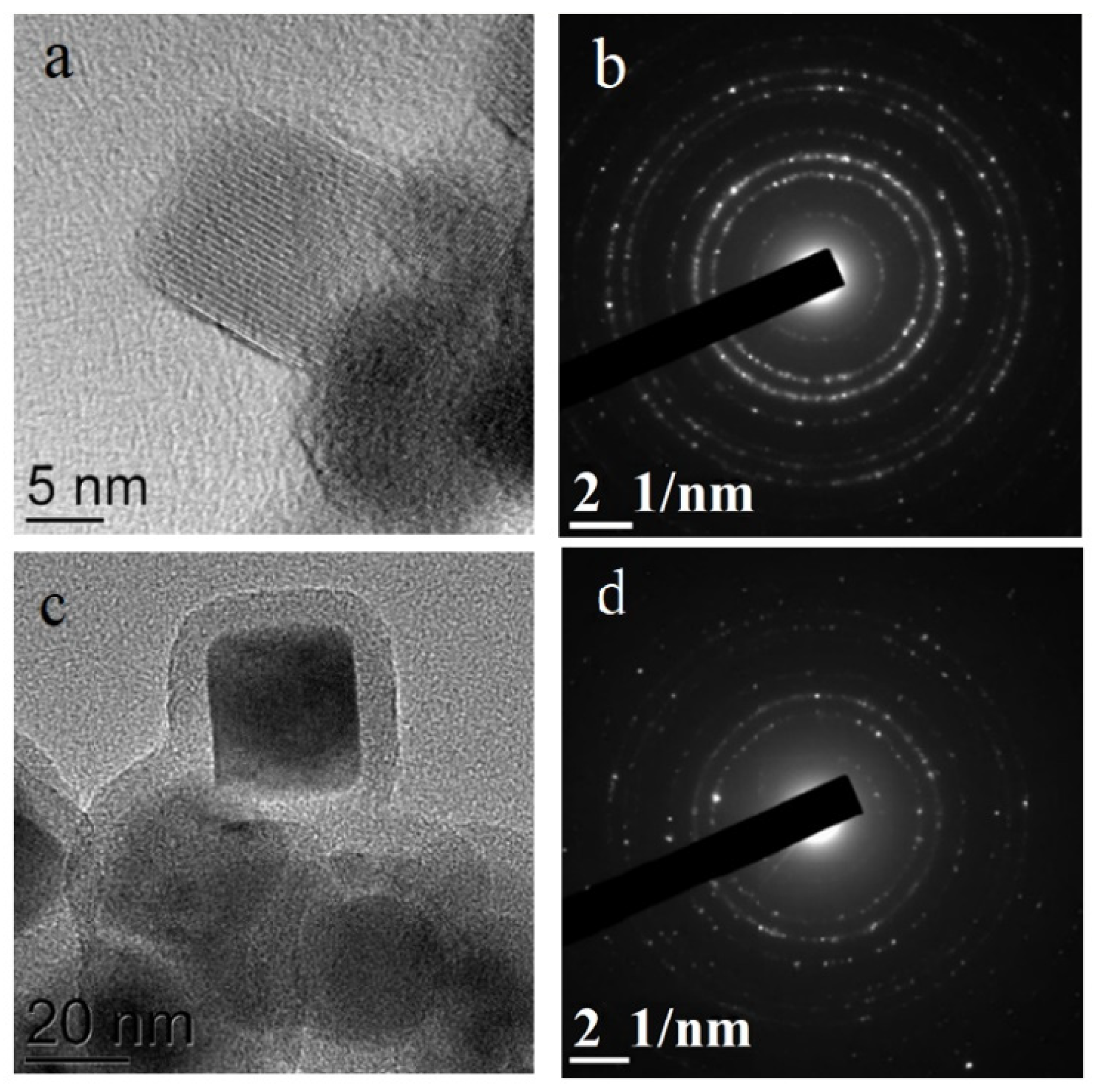

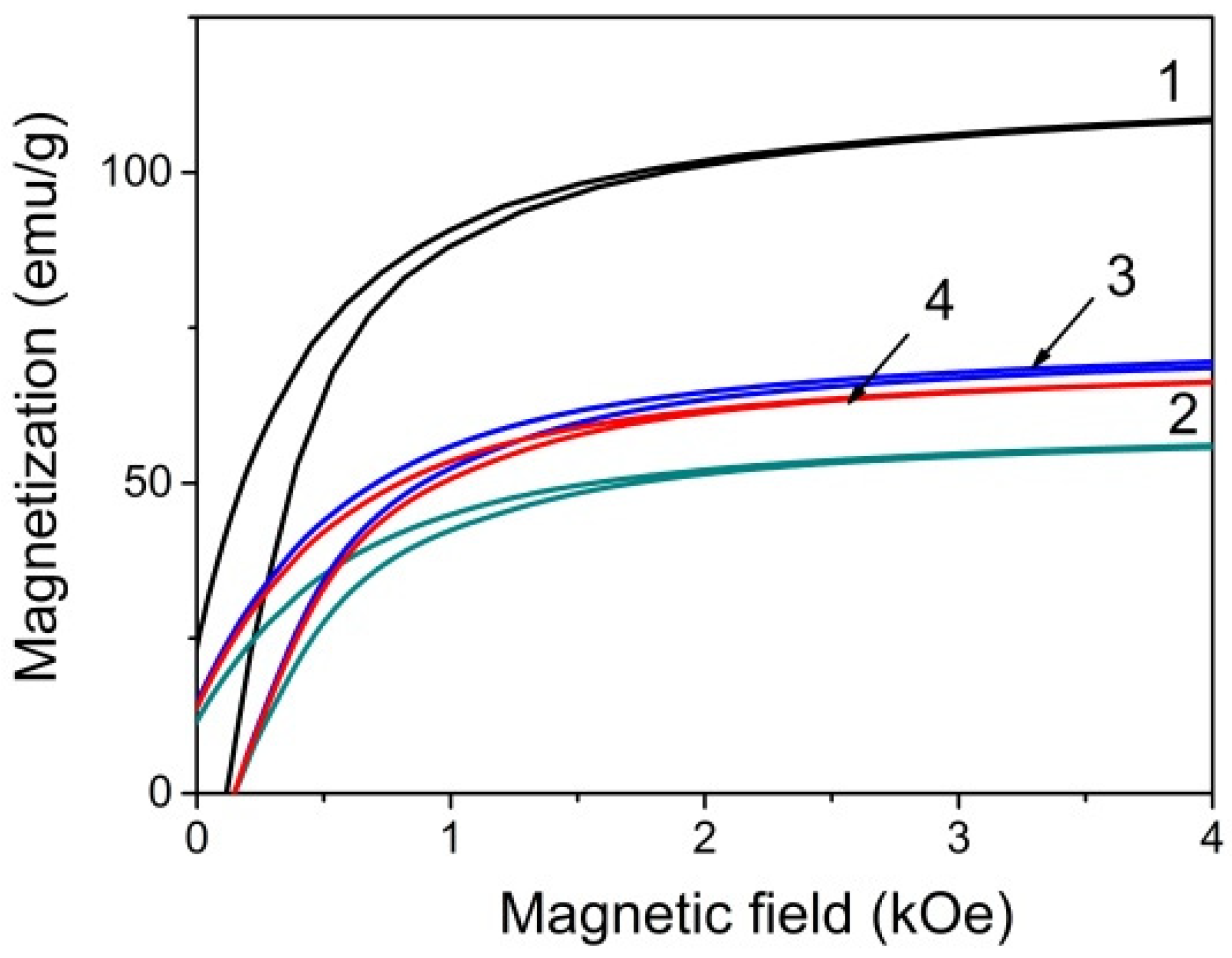

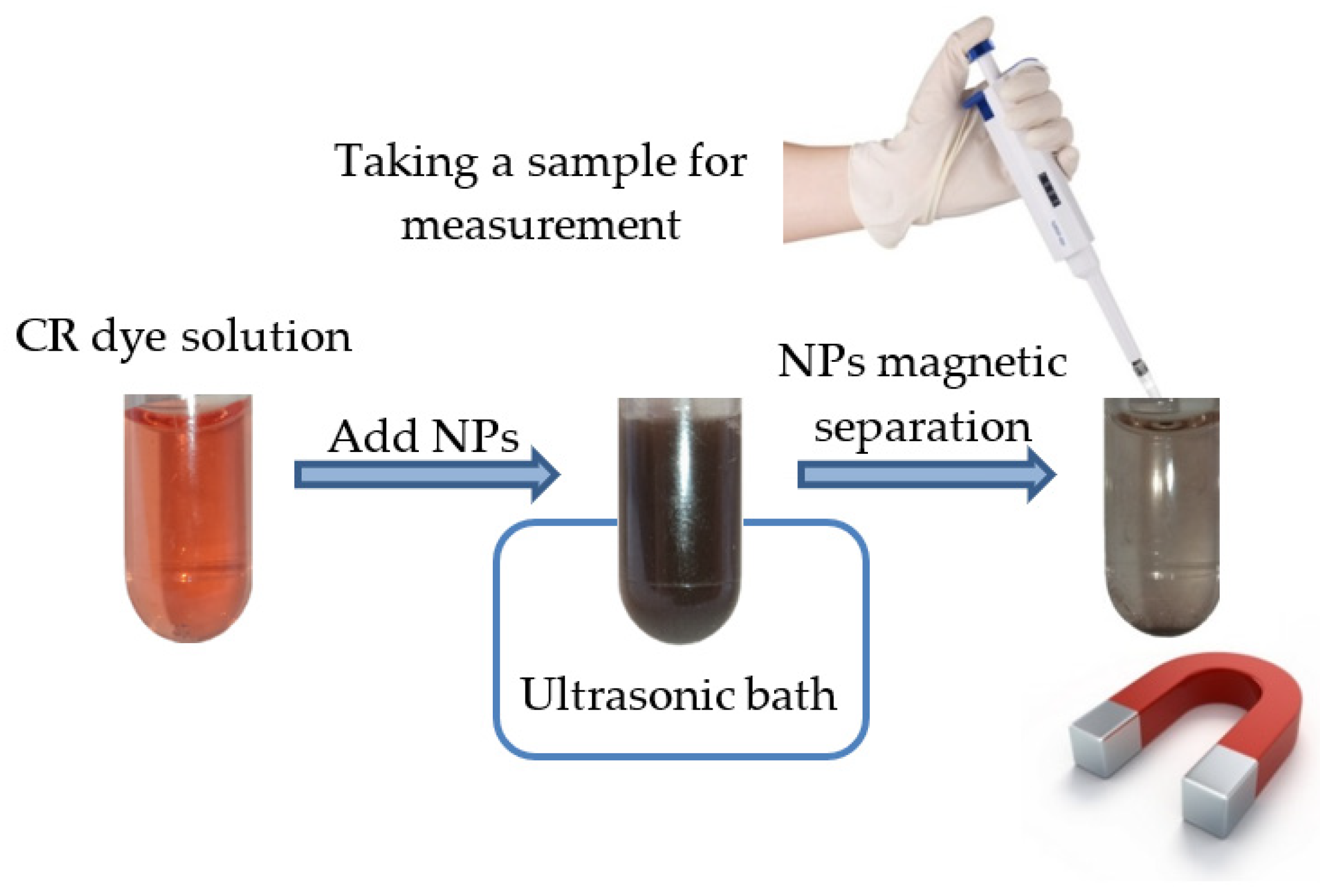
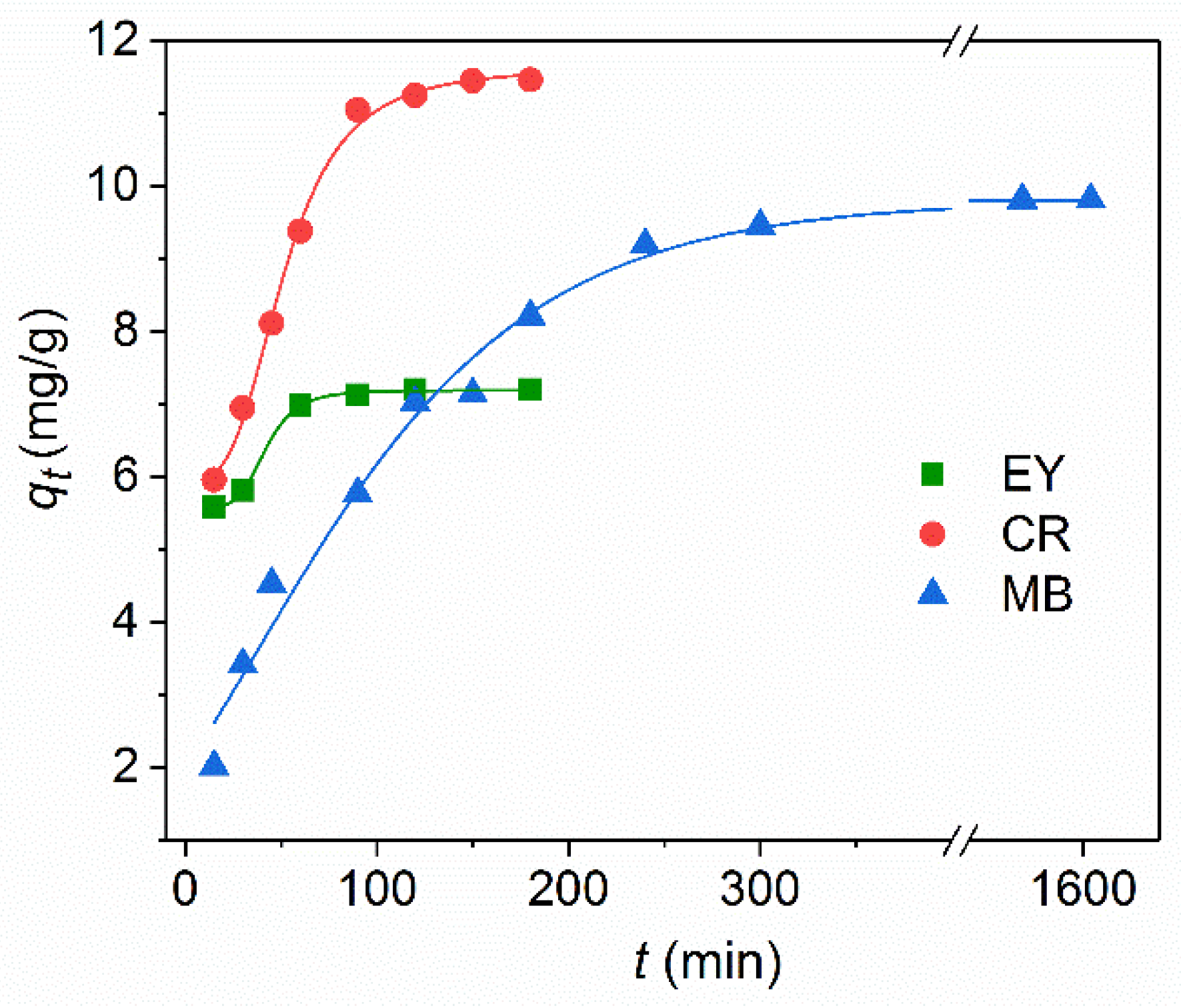
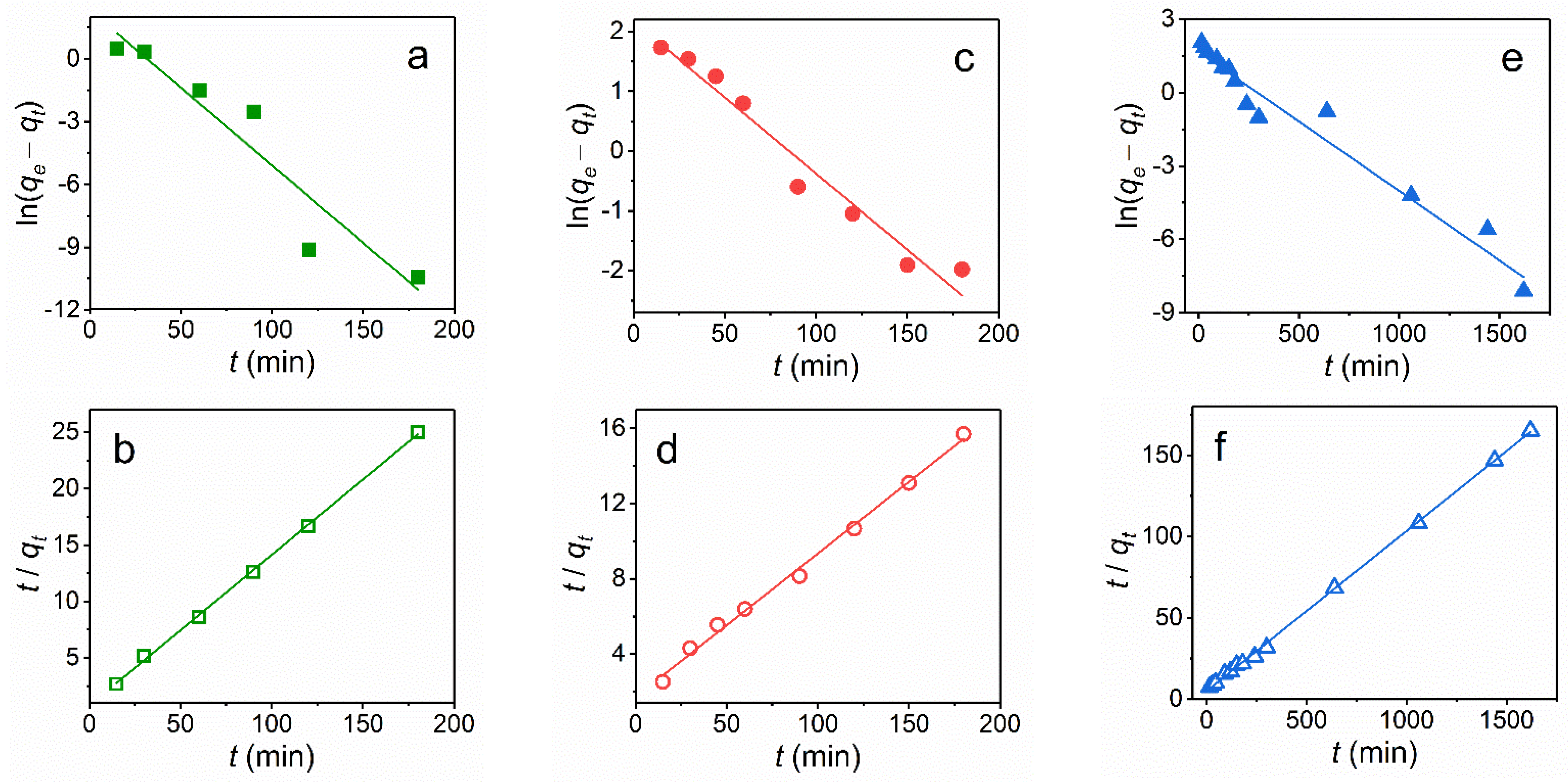
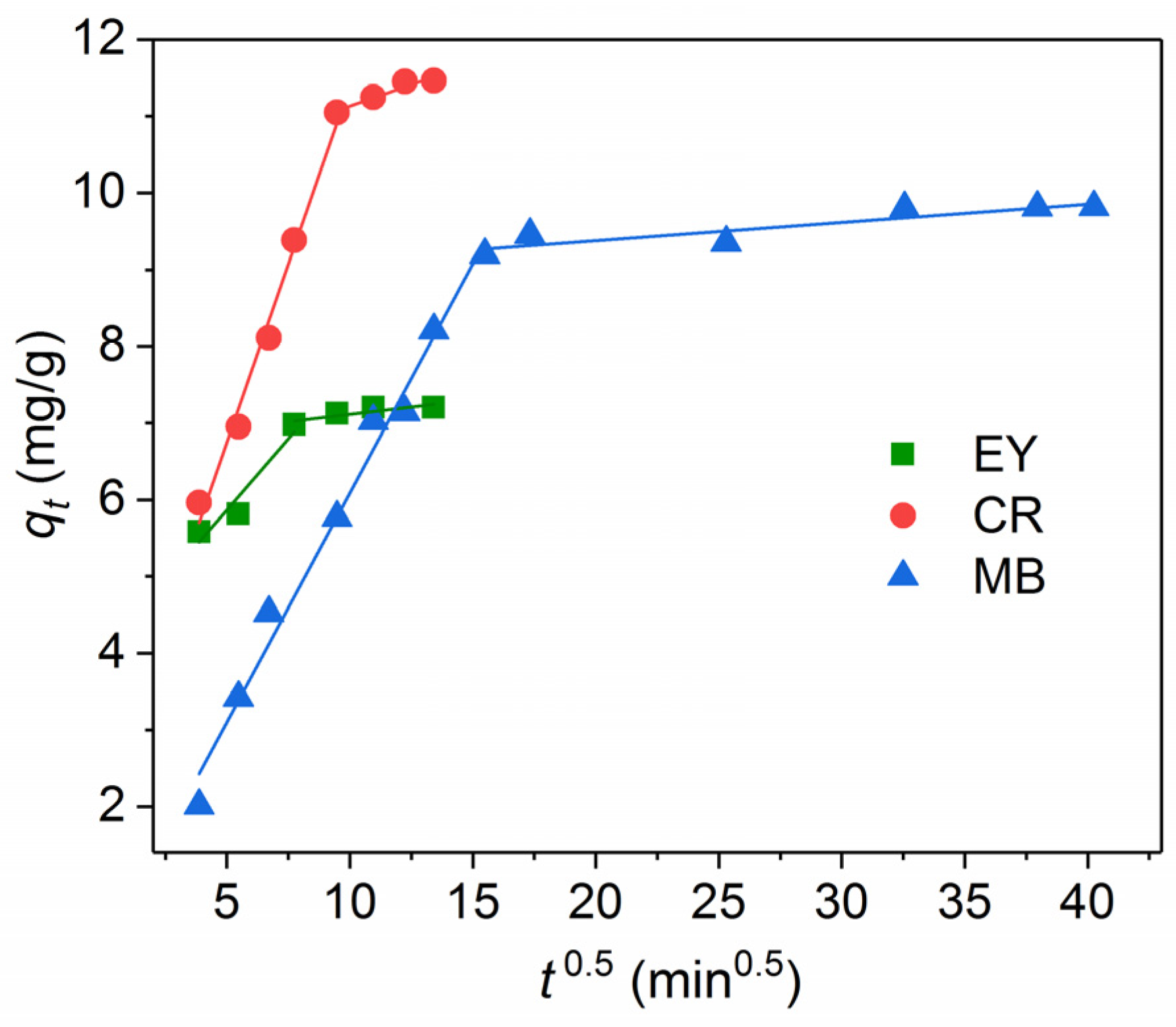

| Kinetics | Parameters | EY | CR | MB |
|---|---|---|---|---|
| Pseudo-first order model | k1 (1/min) | 0.074 ± 0.012 | 0.025 ± 0.002 | 0.0057 ± 0.0003 |
| qe (mg/g) | 10.2 ± 3.4 | 8.7 ± 1.4 | 5.3 ± 1.2 | |
| R2 | 0.903 | 0.964 | 0.970 | |
| Pseudo-second order model | k2 (g/(mg min)) | 0.023 ± 0.005 | 0.0034 ± 0.0005 | 0.0019 ± 0.0002 |
| qe (mg/g) | 7.5 ± 0.6 | 12.6 ± 0.9 | 10.2 ± 0.8 | |
| R2 | 0.999 | 0.995 | 0.999 | |
| Intraparticle diffusion model | ki1 (mg/(g min0.5)) | 0.37 ± 0.07 | 0.93 ± 0.06 | 0.60 ± 0.03 |
| C1 (mg/g) | 4.0 ± 0.6 | 2.1 ± 0.3 | 0.11 ± 0.03 | |
| R2 | 0.938 | 0.988 | 0.986 | |
| ki2 (mg/g min0.5) | 0.04 ± 0.01 | 0.11 ± 0.02 | 0.024 ± 0.006 | |
| C2 (mg/g) | 6.7 ± 0.2 | 10.0 ± 0.3 | 8.9 ± 0.2 | |
| R2 | 0.873 | 0.929 | 0.902 |
| Langmuir Model | Freundlich Model | ||||
|---|---|---|---|---|---|
| qmax, mg/g | KL, L/mg | R2 | 1/n | KF, L/mg | R2 |
| 24 ± 1 | 0.21 ± 0.04 | 0.967 | 0.18 ± 0.04 | 0.010 ± 0.002 | 0.789 |
| Anionic Dye | Adsorbent | qmax (mg/g) | Cationic Dye | Adsorbent | qmax (mg/g) |
|---|---|---|---|---|---|
| CR | Fe3O4@SiO2-NH2 | 24.0 [This work] | MB | Fe3O4@SiO2-NH2 | 20 a [This work] |
| Fe3O4@SiO2-NH2 | 18.0 [29] | Fe3O4@SiO2 | 31.8 [24] | ||
| Fe3O4@SiO2-NH2-MIP b | 35.3 [29] | Fe3O4@SiO2 | 32.3 [23] | ||
| Fe3O4@SiO2 | 36.2 [24] | Fe3O4@SiO2-CR c | 31.4 [34] | ||
| Fe3O4@SiO2 | 14.8 [23] | Fe3O4@SiO2@Zn−TDPAT d | 58.7 [23] | ||
| Fe3O4@SiO2@Zn-TDPAT d | 17.7 [23] | Fe3O4@SiO2-(CH2)3-IL/Talc e | 6.2 [10] |
Publisher’s Note: MDPI stays neutral with regard to jurisdictional claims in published maps and institutional affiliations. |
© 2021 by the authors. Licensee MDPI, Basel, Switzerland. This article is an open access article distributed under the terms and conditions of the Creative Commons Attribution (CC BY) license (https://creativecommons.org/licenses/by/4.0/).
Share and Cite
Lin, C.-R.; Ivanova, O.S.; Petrov, D.A.; Sokolov, A.E.; Chen, Y.-Z.; Gerasimova, M.A.; Zharkov, S.M.; Tseng, Y.-T.; Shestakov, N.P.; Edelman, I.S. Amino-Functionalized Fe3O4@SiO2 Core-Shell Magnetic Nanoparticles for Dye Adsorption. Nanomaterials 2021, 11, 2371. https://doi.org/10.3390/nano11092371
Lin C-R, Ivanova OS, Petrov DA, Sokolov AE, Chen Y-Z, Gerasimova MA, Zharkov SM, Tseng Y-T, Shestakov NP, Edelman IS. Amino-Functionalized Fe3O4@SiO2 Core-Shell Magnetic Nanoparticles for Dye Adsorption. Nanomaterials. 2021; 11(9):2371. https://doi.org/10.3390/nano11092371
Chicago/Turabian StyleLin, Chun-Rong, Oxana S. Ivanova, Dmitry A. Petrov, Alexey E. Sokolov, Ying-Zhen Chen, Marina A. Gerasimova, Sergey M. Zharkov, Yaw-Teng Tseng, Nicolay P. Shestakov, and Irina S. Edelman. 2021. "Amino-Functionalized Fe3O4@SiO2 Core-Shell Magnetic Nanoparticles for Dye Adsorption" Nanomaterials 11, no. 9: 2371. https://doi.org/10.3390/nano11092371







